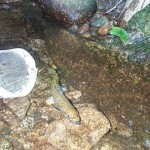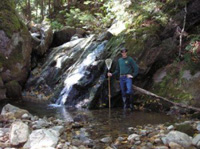Fish Populations in Streams of the Hubbard Brook Experimental Forest

To date, few studies have evaluated fish in streams of the Hubbard Brook Experimental Forest (HBEF). What fish are present in streams in HBEF streams and how are the fish distributed? This project is designed to address these important initial questions that can set the stage for future research on fish in this well studied ecosystem.
 In summer 2005, we conducted initial fish surveys in all Hubbard Brook tributaries and at three locations on the main stem of Hubbard Brook. Brook trout (Salvelinus fontinalis) were the only fish species present in all HBEF tributaries except Norris Brook, which also contained slimy sculpin (Cottus cognatus). In most cases the upstream movement of fish was clearly constrained by a waterfall or other large physical barrier. In a few cases, the mechanism for a loss of fish as one moved upstream was not immediately apparent. We are exploring the possibility that episodic acidification during snow melt moves fish downstream in the spring and that the presence of groundwater seeps are particularly important in maintaining fish in these streams. One chronically acidified stream, contained no fish. No surveys were conducted below the gorge on the main stem of Hubbard Brook. This feature may act as a barrier to fish recolonization by species such as dace or sculpin following their local extirpation due to stream acidification in the 1980’s. Norris brook, which does contain sculpin, enters the main stem below this waterfall. We currently have a manuscript in press in Northeastern Naturalist, documenting the current distribution of fish in the HBEF system.
In summer 2005, we conducted initial fish surveys in all Hubbard Brook tributaries and at three locations on the main stem of Hubbard Brook. Brook trout (Salvelinus fontinalis) were the only fish species present in all HBEF tributaries except Norris Brook, which also contained slimy sculpin (Cottus cognatus). In most cases the upstream movement of fish was clearly constrained by a waterfall or other large physical barrier. In a few cases, the mechanism for a loss of fish as one moved upstream was not immediately apparent. We are exploring the possibility that episodic acidification during snow melt moves fish downstream in the spring and that the presence of groundwater seeps are particularly important in maintaining fish in these streams. One chronically acidified stream, contained no fish. No surveys were conducted below the gorge on the main stem of Hubbard Brook. This feature may act as a barrier to fish recolonization by species such as dace or sculpin following their local extirpation due to stream acidification in the 1980’s. Norris brook, which does contain sculpin, enters the main stem below this waterfall. We currently have a manuscript in press in Northeastern Naturalist, documenting the current distribution of fish in the HBEF system.
Collaborators
- Dr. Clifford Kraft
- Dr. Gene Likens
- Donald C. Buso

